| The T-34 Medium Tank |
|---|
|
|
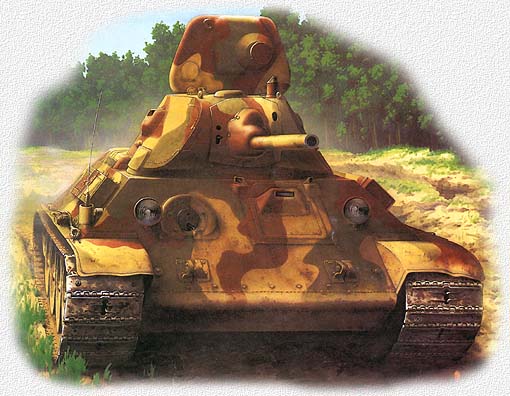
The T-34 medium tank was of a classical layout with rear transmission. The hull was divided in the driver's compartment, fighting compartment, engine bay, and transmission housing.
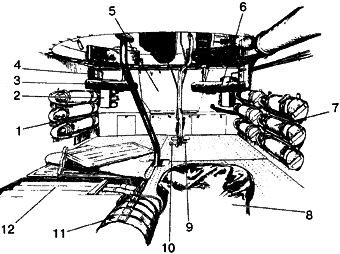 The battle compartment view. | |
| 1. Three rounds on the right side; 2. Magazines for the coaxial MG; 3. The loader's seat; 4. Reserve storage of the optic prisms; 5. The bulkhead; 6. The commander's seat; |
7. Six rounds on the left side; 8. The driver's seat; 9. The trigger pedal of the gun; 10. The trigger pedal of the MG; 11. Magazines for the bow MG; 12. Ammo boxes on the floor. |
The steering unit was placed in the front hull, with a driver and a radio operator's station, operating controls, devices and gauges, the bow 7.62 mm DT machine-gun in a spherical mount, some ammunition, radio (initially on command tanks only), observation sights, a pair of oxygen bottles for emergency starting of the engine, some spares, instruments and additional equipment.
The fighting compartment was situated in the middle of the tank, with a commander's and a loader's station. On the hull top in front, on ball bearings , was the turret containing some ammunition, the main gun with coaxial 7.62 mm DT machine gun and observation sights. There were one or two hatches in the turret roof (depending on the type of turret).
The engine compartment was located behind the fighting compartment. These compartments were separated by a removable bulkhead with two round hatches in it. The engine compartment contained the engine, two water radiators, two oil radiators and four accumulators.
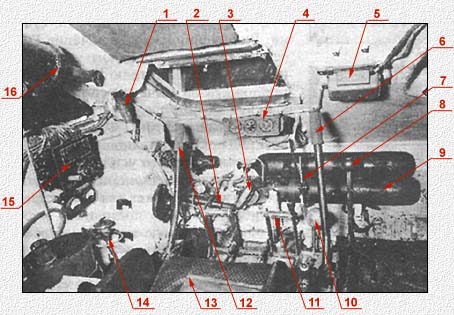 | |
| 1. Speedometer and tachometer; 2. The pedal of the main friction clutch; 3. The hand air pump; 4. Control devices; 5. The TPU internal connection; 6. The right steering lever; 7. The holder; 8. The gear shift lever; |
9. The cylinders with compressed air; 10. The fuel injection pedal; 11. The foot-brake pedal; 12. The left steering lever; 13. The driver's seat; 14. The air distributor; 15. The electric dashboard; 16. The balancing mechanism of the hatch. |
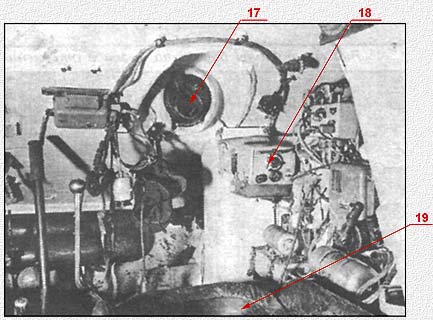 |
| 17. The bow MG; 18. The radio; 19. The radio operator's seat. |
The transmission compartment was located in the rear. In it were the main friction clutch with centrifugal blower, the gearbox, side clutches with brakes, electric starter, transfer box, side gears and two fuel tanks.
The hull was a rigid armored box with oblong rounded nose. It was made of rolled homogenous armored plate (steel grade MZ-3 or I8-S), welded together. The upper armor was sloped to increase it's protection. Main parts of the hull were: bottom, nose, sides, rear, roof and a bulkhead.

The bottom consisted of two armored plates, which were welded butt. The joint was strengthened by a T-shaped steel girder, welded or riveted to the bottom (depending on the factory). Often the first bottom plate was slightly thicker then the second one (20-22 mm to 16-20 mm). The emergency hatch was in the first bottom plate, in the second were three hatches for maintenance, six apertures fitted with plugs and eight openings (four per side). The engine was screwed to the engine bay. This bay consisted of two transversal holders on which two parallel frames were fastened by 36 bolts.

The nose of the hull consisted of a frontal girder, three armored plates, driver's hatch and armored mantlet for the bow machine-gun. The upper armor plate was welded butt to the frontal girder, side armored plates, and to the upper hull (roof). In 1942, the upper frontal plate and side plates were tongued and welded on the hulls which were manufactured by the Stalingrad shipyard (factory #264).

On the left of the glacis was the driver's hatch for the driver and radio operator, In it three observation periscopes were mounted. Somewhere in the beginning of 1942, this hatch was simplified, now equiped only with two prismatic periscopes taken from the A-43 project. These periscopes were protected by tip-up armored covers.
On the right side of the glacis the bow DT machine-gun was located. From 1942 on the DT received an armored mantlet except tanks being manufactured by STZ. The hull sides consisted of two parts: the lower and upper belts. The lower belt was placed vertically and had five holes for the swing arms for the road wheels. On the front of the lower belt was a housing for the track tensioning mechanism. I must notice that track tensioning was a real pain for the crew, the tracks could be tensioned by three men equipped with one sledge-hammer and a couple of a hundred coarse words. All attempts to simplify this process failed and the rest of the war Soviet tankers troubled with tracks tensioning. The upper belt was sloped on 40°. On the inside were ten housings with vertical coil-springs for the Christie suspension (five housings per side). Between these housings were four oil tanks located to the rear (as shown in the photo) and four fuel tanks located to the front. These fuel tanks could cause the complete destruction of the tank, if they were half-empty and were hit with an AP round, here you can see on how it looks. The rear hull consisted of upper and lower armored plates and two housings for the side gears. The upper plate of trapezoid form was fastened to the lower plate and side belts, in it was a right-angled hatch. From 1942 on this was replaced with a round one (except tanks of the STZ factory). To the left and right of this hatch were two holes for the exhausts protected with armored covers. |

The rear hull consisted of upper and lower armored plates and two cases of the side gears. The upper plate of trapezoid form fastened to the lower plate and side belts. There was the right-angled hatch. From 1942 it was replaced with rounded hatch (excluding the tanks of STZ factory). Besides the hatch, there were two holes for exhausts which were protected with armored casings.
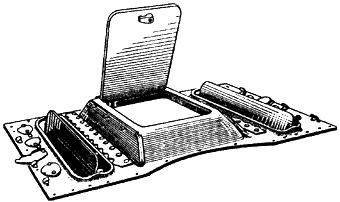 The rear engine's deck of the T-34-76 model 1940 |
The rear armored deck behind the turret was slightly raised. It had four openings for quick access to the suspension elements. The engine's cover (rear deck) consisted of a longitudinal plate with a hatch to access the engine, a pair of plates placed over the radiators, a pair of longitudinal grills and domes over the radiators. The armored deck over the transmission compartment consisted of two armored plates over the main fuel tanks, a narrow transversal plate and a wire mesh screen. |
There were several types of turrets of the T-34:
In fact, the differences of all of these types were superficial, so let's examine the welded turret as an example.
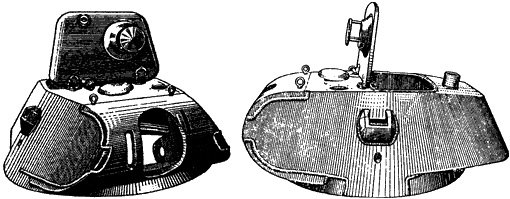
It was mounted on ball bearings and was placed over the fighting compartment of the tank. In the turret front were three openings for the main gun, the coaxial DT machine-gun and for the telescopic sight. In the turret side plates were two openings for observation sights and two pistol ports.

In the rear plate was a trapezoid hatch fastened with four or six screws. This hatch was used to replace the gun if it was damaged. Tanks being manufactured by the "Krasnoye Sormovo" Factory didn't have the hatch at all.
The turret top hatch was very clumsy, occupying the entire rear part of the roof, making it heavy to lift and also blocking the commanders view when open. Only one observation periscope was fitted to the hatch; at the left-hand front side. From the autumn of 1941 on this periscope was removed and it's opening was welded over. In 1942 this opening was discarded at all. In the front upper deck were two openings; left for the periscope sight and the right one for the ventilator (covered with an armored cover). From the end of 1941 on there were two openings for the sights; on the left and right of the ventilator. Tanks of the first production batches had an antenna hole in the rear turret. Further deliveries didn't have it or it was welded over, because of the radio, which was relocated from the turret to the hull. In 1942 a new hexagonal turret was developed. It was either cast or pressed (depending on the factory). It's frontal plate had a rectangular opening for the armament installation. On the outside this was covered with an armored gun shield, which was fastened with screws. The turret sides had observation sights. From 1943 on there were two pistol ports, these ports could be locked by conic plugs. |
The turret roof was made of a single flat plate. On the front left side was an opening for the periscope sight, command tanks aslo had a panoramic sight on the right front. In the middle of the turret top plate were two round hatches for commander and loader. Between these hatches was a bulkhead, which was made removable to make it easier to take out the side fuel tanks through the turret, otherwise the turret should be removed first. In the rear turret roof was a ventilator which was protected by an armored lid. From 1943 on some tanks were equipped with a cylindrical commander's cupola. Such tanks didn't had an removable bulkhead between the hatches, so the internal fuel tanks could only be taken out after the turret being taken away. Turrets of all types could be traversed with the aid of an electric traversing motor or by hand wheel operated by the commander. With the aid of an electric motor the turret could be traversed on 360 degrees in 14 seconds. |
First production T-34's (also known as Model 1940) were armed with the 76.2 mm Tank Gun L-11 Model 1938/39 (see the Table 1). The gun had a semi-automatic (self-locking) vertical breech-block, alghough the self-locking mechanism could be turned off.
| Parameter | L-11 | F-34 |
|---|---|---|
| Caliber, mm | 76.2 | 76.2 |
| Barrel length, clb | 30.5 | 41.5 |
| Weight, kg | ? | 1,155 |
| Recoil length, m | ? | 0.39 |
| Elevation | - 5° +25° | - 5°30' +25.6°48' |
| Practical rate of fire, shots/min | 1-2 | 2-4 |
From February-March 1941 on the more modern and powerful gun was accepted to be used for the T-34's main armament: the 76.2 mm Tank Gun F-34 Model 1940 (see the Table 2). This gun had a self-loading breech-block. Its recoil mechanisms consisted of a hydraulic recoil buffer and a recoil spring which were located under the barrel. The gun could be fired in two different ways, either by hand or by foot pedal.
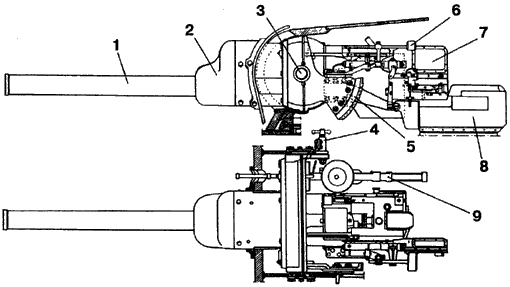 The L-11 tank gun | |
| 1. The barrel; 2. The gun mantlet; 3. The trunnion; 4. The stow lock; 5. The gear quadrant; |
6. The headrest of the sight; 7. The pillow; 8. The shell-bag; 9. The coaxial MG. |
The F-34 gun has been modernised twice. During the first modernisation the breech-block and self-loading mechanism were altered; the canceller and buffer were removed. During the second modernisation the new monoblock gun was connected with the breech-end by a special muff.
Besides it's gun, the T-34 was armed with two 7.62 mm DT machine-guns where the "DT" abbreviation means "Degtyarev's tankoviy" (a tank variant of Degtyarev's machine-gun). One of these machine-guns was made coaxial with the main gun, the other MG was mounted in a spherical installation in the glacis.
 The F-34 tank gun | |
| 1. The thimble; 2. The telescopic sight; 3. The sight's holder; 4. The recoil ruler; 5. The headrest of the sight; 6. The eye shade; |
7. The horizontal adjustment; 8. The angular adjustment; 9. The trigger; 10. The elevation mechanism; 11. The hand wheel |

The L-11 gun equipped with the TOD-6 telescopic sight and PT-6 periscope panoramic sight. The F-34 gun equipped with TOD-7 telescopic sight and PT-7 panoramic sight, later they were replaced with a TMFD-7 telescopic and a PT-4-7 panoramic sight. Command tanks equipped with an additional PT-K panoramic observation sight.
Both the L-11 and the F-34 used the same ammunition, mostly from the 76 mm Divisional Gun Model 1902/30 and from the 76 mm Regimental Gun Model 1927 (see Table 3).
| Round index | Projectile index | Type | Fuse | Projectile weight, kg | Description |
|---|---|---|---|---|---|
| UOF-354M | OF-350 | fragmentation | KTM-1 | 6.2 | steel case; long range |
| UOF-354A | OF-350A | fragmentation | KTM-1 | 6.23 | steely iron case; long range |
| UF-354 | F-354 | high-explosive | KT-3, KTM-3, 3GT | 6.41 | old Russian type |
| UBR-354A or UBR-353A | BR-350A | armor-piercing | MD-5 | 6.3 | with tracer |
| UBR-354B or UBR-353B | BR-350B | armor-piercing | MD-5, MD-8 | 6.3 | with tracer |
| UBR-354SP or UBR-353SP | BR-350SP | armor-piercing | n/a | 6.3 | solid; with tracer |
| UBR-354P | BR-350P | sub-caliber | n/a | 3.02 | introduced in October 1943 |
| USh-354 | Sh-354 | shrapnel | 22-second | 6.5 | bullet shrapnel |
| USh-354T | Sh-354T | shrapnel | T-6 | 6.5 | bullet shrapnel |
| USh-354G | Sh-354G | shrapnel | 22-second | 6.58 | Gartz's shrapnel |
| USh-R2-354 | Sh-361 | shrapnel | T-3UG | 6.61 | bar shrapnel |
| UShe-354 | She-350 | case-shot | ? | ? | - |
Here I would like to point out on a fact, that despite some publications the T-34 did never use any hollow-charge (HEAT) ammunition. Usually publications refer to the UBP-354A, although it was a round for regimental guns, it was prohibited to use for the L-11 and for the F-34 guns because it exploded inside the barrel.
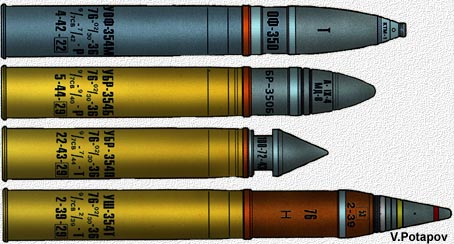
| - the high-explosive fragmentation round UOF-354M; - the armor-piercing round UBR-354B; - the armor-piercing subcaliber round UBR-354P; - the bullet shrapnel round USh-354T. |
Tanks model 1940 and model 1941 had 77 rounds which were located on the floor (68 rounds) and the sides (9 rounds) of the fighting compartment.
Tanks model 1942 with hexagonal turret had 100 rounds: 75 high-explosive and fragmentation rounds, 21 armor-piercing rounds and 4 sub-caliber rounds. These ammunition was located on the floor (8 boxes with 86 rounds in total) of the fighting compartment.
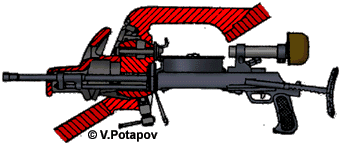 The DT machine-gun mount. |
The other ammunition was distributed as following: 2 AP rounds with tracers were stored in the installation on the right rear corner of the compartment; 8 fragmentation rounds were stored on the left side of the compartment; 4 sub-caliber rounds were stored in the installation on the right side of the compartment.
Here you can see the typical result of exploding of the ammunition stored in the bottom of the T-34.
Initially, tanks of the first deliveries with radio had 46 magazines for it's machine-guns. The magazine had 63 rounds capacity, thus, 2898 rounds total. Tanks without radio had 75 magazines (4725 rounds). Tanks with hexagonal turret had 50 magazines (3150 rounds), one PPSh sub-machine gun supplied with four magazines, and 25 grenades F-1 ("pineapples").
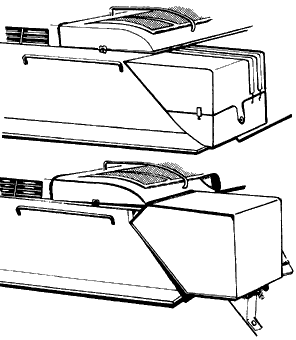 The squared fuel tanks: small (above) and big (below). |
The T-34 tank had the V-2-34 12-cylinder diesel engine (see Table 4). It consumed either diesel oil type "DT" or gas-oil type "E" (OST 8842). In any case, fuel was fed by the NK-1 12-plunger injection pump. The tanks of the first deliveries had 6 internal fuel tanks with a total capacity of 460 liters plus 4 external fuel tank with a total capacity of 134 liters. By the end of the summer of 1943 the total number of all fuel tanks was increased up to 8 and their summary capacity was 540 liters. Four external fuel tanks were replaced with two rear placed squared fuel tanks, from 1943 on they were replaced with two cylindrical fuel tanks of 90 liters each. Soon, their number was increase by a additional 90-liter fuel tank. They were placed on both sides of the tank: one tank on the left side and two tanks on the right side. Usually one of them was filled up with oil (the V-2 consumed a tremendous amount of oil!). The external fuel tanks didn't plug in the engine's feed system. |
| Parameter | V-2-34 |
|---|---|
| Type | four-cycle |
| Number of cylinders | 12 |
| Dry weight, kg | 750 |
| Nominal power (1750 revs), h.p. | 450 |
| Service power (1700 revs), h.p. | 400 |
| Max power (1800 revs), h.p. | 500 |
| Cylinder bore, mm | 150 |
| Left piston stroke, mm | 180 |
| Right piston stroke, mm | 186.7 |
| Angle between cylinders | 60° |
| Compression ratio | 14-15 |
The lubrication system was circulated by the lubricating pump unit.
The cooling system was water-cooled by the water pump unit. Two radiators which were placed on both sides of engine, their total capacity was 95 liters.
 The engine's compartment |
| 1. The oil tanks; 2. The engine; 3. The air filter; 4. Pipes of the cooling system; 5. The boxes with elements of suspension. |
T-34's of the first deliveries had one "Pomon" air-filter, later it was replaced with two improved "Cyclone" air-filters.
The engine could be started either by electric starter (15 h.p.) or by compressed air (there were two oxygen bottles in the steering compartment).
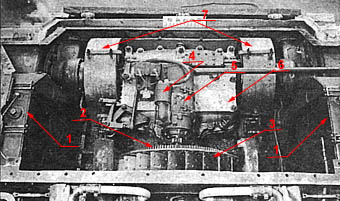 The transmission compartment |
| 1. The rear fuel tanks; 2. The main friction clutch; 3. The ventilarot; 4. The electric relay; 5. The electric starter; 6. The gearbox; 7. The side friction clutshes. |
The transmission consisted of the main friction clutch of dry friction (steel over steel), the gearbox, the brakes, the side clutches and the side gears. The fist gearbox was four-speed, from the end of 1942 on it was replaced with an advanced five-speed gearbox.
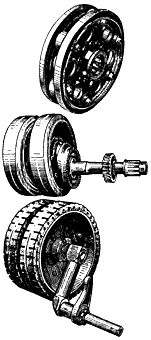 The driving wheel, the idler with rubber tyre, and the road wheel |
The tank chassis consisted of five doubled road wheels (diameter 830 mm), the idler and the drive sprocket. Road wheels of different factories distinguished significantly. There were: 1. cast with rubber tyre; Each road wheel had an independent suspension mounted on a vertical coil-spring. The idler was casted, on early tanks it had a rubber tyre. Tracks were either cast or pressed. On early tanks tracks consisted of 74 links (37+37) 550 mm wide. From 1942 on tanks received new tracks consisting of 72 links (36+36) 500 mm wide. |
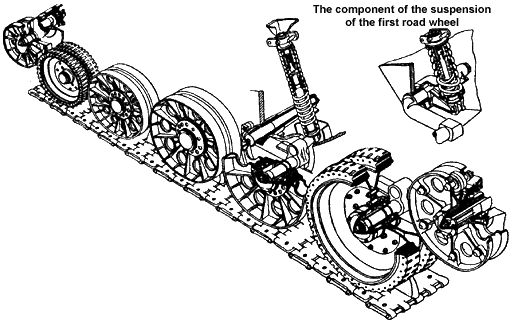
The electric circuit of the T-34 was single-wire. Voltage 24V and 12V. Current sources: the GT-4563A generator (1 kilowatt), four 6-STE-128 accumulators of capacity 128 Ah each. Consumers: the ST-700 electric starter, electric traversing motor of the turret, ventilator, control and monitoring devices, electric horn, dynamotor of the radio.

The T-34 tanks of the first deliveries were equipped with the 71-TK-3 short-wave simplex radio. In 1941 it was replaced with the 9-R short-wave simplex radio. From 1943 on all T-34's (both T-34-67 and T-34-85) were equipped with the modernised 9-RM 71-TK-3 short-wave simplex radio with extended range.
The internal communication in tanks of the first deliveries was by means of the TPU-2 or TPU-3 of pre-war design. Later, all T-34's were equipped with the improved TPU-3-bisF. Anyway, only the commander and the driver had internal communication. The radio operator and the loader didn't.
Sources:
"The T-34 medium tank. Album of construction elements", NKTP, 1941; "The T-34 tank. Maintenance", NKTP, 1941; "The T-34 tank. Operational manual", Voenizdat, 1941; Bronekollektsiya #3, 1999; I.Shmelev "The T-34", Technics and Armament #11-12, 1998; J.Magnuski "Wozy bojowe", LWP, Warsawa, 1985; S.Zaloga, J.Grandsen "T-34 in action"; Cover picture - A.Aksenov |